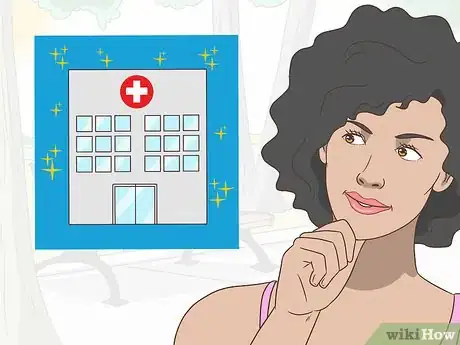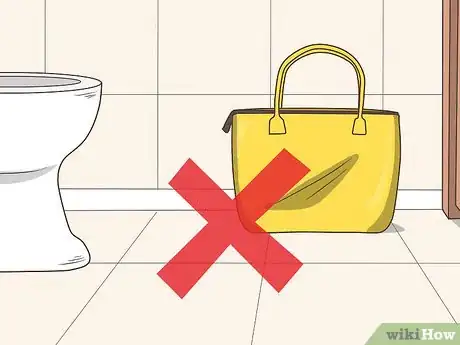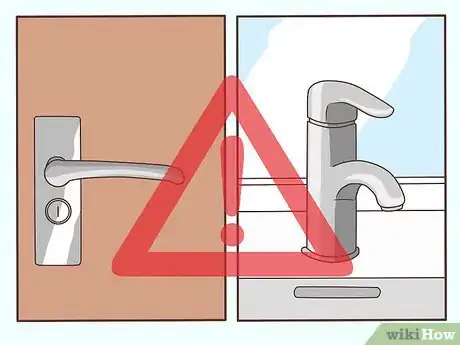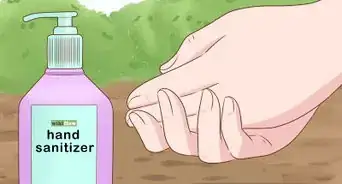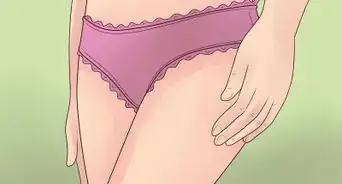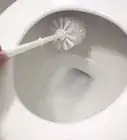This article was co-authored by Chris M. Matsko, MD. Dr. Chris M. Matsko is a retired physician based in Pittsburgh, Pennsylvania. With over 25 years of medical research experience, Dr. Matsko was awarded the Pittsburgh Cornell University Leadership Award for Excellence. He holds a BS in Nutritional Science from Cornell University and an MD from the Temple University School of Medicine in 2007. Dr. Matsko earned a Research Writing Certification from the American Medical Writers Association (AMWA) in 2016 and a Medical Writing & Editing Certification from the University of Chicago in 2017.
This article has been viewed 161,121 times.
Using a toilet stall in a public restroom can be an uncomfortable proposition, as many people are hesitant to enter a public facility due to fears of coming in contact bacteria and germs. Public bathrooms can contain several kinds of harmful bacteria like E.coli, salmonella, coliform, rotavirus, and cold virus.[1] However, these bacteria do not survive long outside of the body and are not any more dangerous than the germs you might find in an average home.[2] [3] Though not all public bathrooms are created equal, and some will be dirtier than others, if you look for a clean bathroom and follow good bathroom etiquette, you should be able to avoid getting too close to bacteria or germs.
Steps
Locating a Clean Public Bathroom
-
1Know where to find the cleanest public restrooms. To limit your contact with bacteria and germs you should try to only use toilet stalls in hospitals and buildings that are cleaned regularly. Hospitals usually have the cleanest toilet stalls as they use disinfectants often and heavily.[4]
- If possible, avoid bathrooms in airports. Airports are high traffic areas and their bathrooms may not be cleaned enough due to the high volume of people using them throughout the day.
- Also, avoid airplane bathrooms. Airplane bathrooms are very small, making it difficult for people to wash their hands. This leads to bacteria on high-touch surfaces.
-
2Go for the first stall. People tend to use the middle and last stall for a bit of privacy, so go for the first stall to limit your exposure to bacteria and germs. It will likely be less used and cleaner than the other stalls in the bathroom.[5]Advertisement
-
3Do not put your belongings on the bathroom floor. A study found that the highest concentration of germs in public bathrooms are on the bathroom floor. The second highest concentration of germs are on sanitary napkin disposals and the sinks and water taps in bathrooms.[6] Avoid picking up any bacteria or germs from the bathroom by hanging up your bag or coat on the hook rather than placing it on the floor, or leaving it outside with a friend while you use the bathroom.
- If there is no hook on the back of the door of the stall, hang your bag around your neck or keep your coat on as you use the bathroom.
Preventing the Spread of Bacteria and Germs
-
1Do not be afraid to sit on the toilet seat. Skin contact with urine or fecal matter on the toilet seat may be unpleasant, but they are not clear health hazards. You are more at risk of picking up germs and bacteria through touching bathroom surfaces with your hands and then not washing them, rather than through your skin on your bottom.[7]
- Ideally, avoid touching the flush handle or the stall door with your hands. You can easily transmit bacteria from your hands to your face or your mouth without realizing it.
-
2Wash your hands after going to the bathroom. This seems obvious, but it is essential that you always wash your hands well after you use a toilet stall in a public bathroom. This will cut down significantly on the transfer of bacteria and fecal matter from your hands, via surfaces in the bathroom, to your face, mouth, or eyes.[8]
- To properly wash your hands, use soap and lather your hands for 20 seconds.
- Rinse your hands well and dry with a paper towel or a hand dryer.
- Avoid touching the bathroom door as you leave, as you don’t want to pick up any additional germs or bacteria from people who didn't wash their hands.
-
3Limit your contact with surfaces, such as door handles and sinks. If possible, try to restrict your contact with surfaces in the bathroom so you do not get bacteria or germs on your hands. Use the automatic soap dispenser if it is available and the automatic taps to wash your hands. An automatic hand dryer can also be a good way to avoid having to touch the paper towel dispenser on your way out of the bathroom.[9]
Expert Q&A
-
QuestionWould it be better to use a germicide to clean my hands?
 Chris M. Matsko, MDDr. Chris M. Matsko is a retired physician based in Pittsburgh, Pennsylvania. With over 25 years of medical research experience, Dr. Matsko was awarded the Pittsburgh Cornell University Leadership Award for Excellence. He holds a BS in Nutritional Science from Cornell University and an MD from the Temple University School of Medicine in 2007. Dr. Matsko earned a Research Writing Certification from the American Medical Writers Association (AMWA) in 2016 and a Medical Writing & Editing Certification from the University of Chicago in 2017.
Chris M. Matsko, MDDr. Chris M. Matsko is a retired physician based in Pittsburgh, Pennsylvania. With over 25 years of medical research experience, Dr. Matsko was awarded the Pittsburgh Cornell University Leadership Award for Excellence. He holds a BS in Nutritional Science from Cornell University and an MD from the Temple University School of Medicine in 2007. Dr. Matsko earned a Research Writing Certification from the American Medical Writers Association (AMWA) in 2016 and a Medical Writing & Editing Certification from the University of Chicago in 2017.
Family Medicine Physician You can use a Purell gel afterward to kill the bacteria and sanitize your hands.
You can use a Purell gel afterward to kill the bacteria and sanitize your hands. -
QuestionWhat if the back stalls are clean and I use one?
 Chris M. Matsko, MDDr. Chris M. Matsko is a retired physician based in Pittsburgh, Pennsylvania. With over 25 years of medical research experience, Dr. Matsko was awarded the Pittsburgh Cornell University Leadership Award for Excellence. He holds a BS in Nutritional Science from Cornell University and an MD from the Temple University School of Medicine in 2007. Dr. Matsko earned a Research Writing Certification from the American Medical Writers Association (AMWA) in 2016 and a Medical Writing & Editing Certification from the University of Chicago in 2017.
Chris M. Matsko, MDDr. Chris M. Matsko is a retired physician based in Pittsburgh, Pennsylvania. With over 25 years of medical research experience, Dr. Matsko was awarded the Pittsburgh Cornell University Leadership Award for Excellence. He holds a BS in Nutritional Science from Cornell University and an MD from the Temple University School of Medicine in 2007. Dr. Matsko earned a Research Writing Certification from the American Medical Writers Association (AMWA) in 2016 and a Medical Writing & Editing Certification from the University of Chicago in 2017.
Family Medicine Physician We recommend using the first stall; however, if the back stalls are cleaner then by all means use them instead.
We recommend using the first stall; however, if the back stalls are cleaner then by all means use them instead.
References
- ↑ http://www.cnn.com/2008/HEALTH/10/03/bathroom.hygiene/index.html?eref=rss_latest
- ↑ http://www.smithsonianmag.com/smart-news/bathrooms-are-full-same-types-bacteria-and-theyre-not-worrisome-180953517/?no-ist
- ↑ http://www.health.gov.on.ca/en/public/publications/disease/ecoli.aspx
- ↑ http://www.cnn.com/2008/HEALTH/10/03/bathroom.hygiene/index.html?eref=rss_latest
- ↑ http://www.cnn.com/2008/HEALTH/10/03/bathroom.hygiene/index.html?eref=rss_latest
- ↑ http://journals.plos.org/plosone/article?id=10.1371/journal.pone.0028132
- ↑ http://www.cnn.com/2008/HEALTH/10/03/bathroom.hygiene/index.html?eref=rss_latest
- ↑ http://www.cnn.com/2008/HEALTH/10/03/bathroom.hygiene/index.html?eref=rss_latest
- ↑ http://www.cnn.com/2008/HEALTH/10/03/bathroom.hygiene/index.html?eref=rss_latest
About This Article
To safely use a public bathroom, try picking the first stall, since the middle and last stalls tend to be more popular and often have more bacteria and germs. Once you choose a stall, avoid putting your belongings on the floor, since this is one of the dirtiest places in the bathroom. When you’re done using the bathroom, wash your hands thoroughly with soap and hot water for at least 20 seconds to get rid of any bacteria you may have picked up. Then, thoroughly dry them with a paper towel or air dryer. As you leave the bathroom, if you can, use your elbow to open the door so you don’t pick up any more germs. To learn how to find the cleanest public bathrooms, read more from our Medical co-author.
